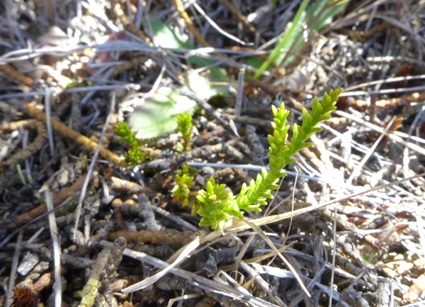Seedlings of the nationally endangered shrub Hebe armstrongii (Armstrong’s whipcord hebe) were recently discovered for the first time at Enys Scientific Reserve in Canterbury by Moa’s Ark Research ecologist Dr Debra Wotton and Department of Conservation botanist Nick Head. Hebe armstrongii is a whipcord hebe found at only two sites in Canterbury: Mounds of Misery and Enys Scientific Reserve. The Mounds of Misery population has numerous seedlings and several hundred adult plants, but occurs on private land with no formal protection. The Enys Reserve population was on the brink of extinction when it was discovered in the 1970’s, with only six plants remaining.

Debra Wotton was recently awarded the David Given Threatened Plant Scholarship to investigate factors limiting recruitment of Hebe armstrongii. Fittingly, the scholarship is named after the late Dr David Given, who discovered the Mounds of Misery Hebe armstrongii population. Debra previously conducted a seed sowing experiment, in collaboration with Prof Richard Duncan (University of Canberra) and Dr Bill Lee (Landcare Research), which found that Hebe armstrongii recruitment at Enys Reserve was limited entirely by the availability of suitable microsites for germination and seedling establishment. Of nearly 2500 seeds sown on bare ground, none established as seedlings three years after sowing. In March 2013, Debra visited Enys Reserve to check the experiment accompanied by Nick Head, where they discovered 12 Hebe armstrongii seedlings that had established naturally under the canopy of adult plants.
Hebe armstrongii was first collected in the 1860’s in the upper Rangitata and Mackenzie basin by the Armstrongs (father and son, after whom the species is named), but there are no modern records from these locations. Hebe armstrongii was not observed again in the wild until the Enys Reserve population was discovered by Dr Peter Wardle in 1974. At that time, the population consisted of only six adult plants. Dr Brian Molloy monitored the original six plants and conducted transplant trials during the 1970’s and 1980’s. Although the land was fenced to exclude stock in 1978 and gazetted as a reserve in 1985, some grazing by cattle and sheep occurred up until 1988, when a hare-resistant fence was erected. Although initial transplanting of seedlings into the reserve to increase the population met with mixed success, several transplants are now thriving and producing seed.
The discovery of Hebe armstrongii seedlings at Enys Reserve nearly thirty years after the reserve was established suggests this population may now be on the road to recovery. Debra’s research will shed light on what conditions are needed to ensure successful recruitment, and thus population persistence, in this nationally endangered species.